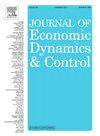失业救济金延期是否能解释失业复苏的出现?
IF 2.3
3区 经济学
Q2 ECONOMICS
引用次数: 0
摘要
在美国,反周期性的失业救济金延长作为一种传播机制,导致了近期经济衰退后失业率的高持续性,以及失业率与生产率之间的弱相关性。我们通过修改劳动力市场的标准摩擦模型,纳入根据美国数据估算的失业保险随机和状态依赖过程,证明了这一点。考虑到生产率和失业保险的变动,我们的校准模型与战后劳动力市场动态一致。它解释了 20 世纪 90 年代出现的失业复苏、失业与生产率之间的低相关性以及衰退后贝弗里奇曲线的明显移动。本文章由计算机程序翻译,如有差异,请以英文原文为准。
Do unemployment benefit extensions explain the emergence of jobless recoveries?
Countercyclical unemployment benefit extensions in the United States act as a propagation mechanism, contributing to the high persistence of unemployment following recent recessions, as well as the weak correlation between unemployment and productivity. We show this by modifying an otherwise standard frictional model of the labor market to incorporate a stochastic and state-dependent process for unemployment insurance estimated on US data. Accounting for movements in both productivity and unemployment insurance, our calibrated model is consistent with post-war labor-market dynamics. It explains the emergence of jobless recoveries in the 1990s, the low correlation between unemployment and productivity, and the apparent shifts in the Beveridge curve following recessions.
求助全文
通过发布文献求助,成功后即可免费获取论文全文。
去求助
来源期刊

Journal of Economic Dynamics & Control
ECONOMICS-
CiteScore
3.10
自引率
10.50%
发文量
199
期刊介绍:
The journal provides an outlet for publication of research concerning all theoretical and empirical aspects of economic dynamics and control as well as the development and use of computational methods in economics and finance. Contributions regarding computational methods may include, but are not restricted to, artificial intelligence, databases, decision support systems, genetic algorithms, modelling languages, neural networks, numerical algorithms for optimization, control and equilibria, parallel computing and qualitative reasoning.
 求助内容:
求助内容: 应助结果提醒方式:
应助结果提醒方式:


